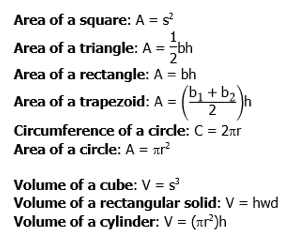I will confess, I feel a certain pedagogical ambivalence about offering this list of Praxis math formulas for Praxis Core Math. It’s absolutely true that for success in the Praxis Mathematics Test, you should be familiar with some basic formulas; in this vein, it’s worthwhile to share these formulas with students.
Beware, though: one of the biggest mistakes math students can make is to mistake the knowledge of a formula for genuine mathematical understanding. Knowledge of all the formulas is liking knowing all the rules for how the pieces move in chess: yes, that knowledge is essential for play, but mastery of these basic rules is only the beginning—that knowledge alone doesn’t automatically make one a world-class chess master! In this spirit, know these formulas, but recognize how much more there is to learn beyond these.
Numbers and Operations
First, a few patterns stated in variables: these are not so much “formulas” as patterns to recognize.
Commutative Property of Addition: A + B = B + A
Commutative Property of Multiplication: A × B = B × A
Associative Property of Addition: (A + B) + C = A + (B + C)
Associative Property of Multiplication: (A × B) × C = A × (B × C)
Distributive Property: A × (B + C) = AB + AC
Also, an important fraction pattern, Cross Multiplication:
![]()
Finally, the rule for Percents.
![]()
Algebra
Motion problems: D = RT
That’s distance equals rate times time.
Work problems: A = RT
That’s amount equals work rate times time.
Geometry
Units of Measurement
1 foot = 12 inches
1 yard = 3 feet
1 mile = 5280 feet = 1760 yards
1 meter = 100 cm
1 km = 1000 meters
1 mile ≈ 1.6 km
1 decimeter = 10 cm ≈ 4 inches
1 pound = 16 “dry” ounces
1 short ton = 2000 lbs
1 kg = 1000 grams
1 kg ≈ 2.2 lbs
1 cup = 8 fluid ounces
1 pint = 2 cups
1 quart = 2 points = 4 cups
1 gallon = 4 quarts = 16 cups
1 liter = 1000 mL
1 mL = 1 cubic centimeter
1 liter ≈ 1 quart (a liter is a little bigger)
In Coordinate Geometry, it’s good to know
Slope-Intercept Form: y = mx + b
You should understand that m is the slope and b is the y-intercept of the line.
I’ll also give you two formulas for slope
Data Analysis
definition of mean (average): mean = (sum of terms)/(the number of terms)
definition of range: range = (max value) – (min value)
In Probability, you should know the expected number formula.
expected number of successes = (probability)*(number of trials)
You should also know
0 ≤ P ≤ 1
P = 0 means an event is impossible, guaranteed not to happen
P = 1 means an event is certain, guaranteed to happen
Praxis Math Formula Summary
Those are the basic Praxis math formulas. Know these, but appreciate that these formulas are far from the whole story of mathematical understanding. Look to math articles on the blog, and certainly the Magoosh Praxis Math video lessons, for detailed explanations of everything you need to know!






